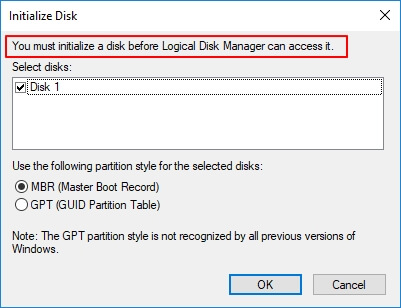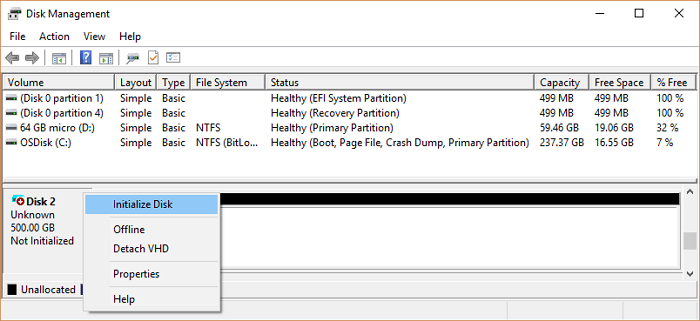-
![]()
-
![]() How to Fix Error Message 'Word was Unable to Read Document. It May be Corrupt' Efficiently
How to Fix Error Message 'Word was Unable to Read Document. It May be Corrupt' Efficiently December 15,2025
December 15,2025 6 min read
6 min read -
![]() How to Fix External Hard Drive Takes Long Time to Open and Read
How to Fix External Hard Drive Takes Long Time to Open and Read December 12,2025
December 12,2025 6 min read
6 min read -
![]() 8 Best Free External Hard Drive Recovery Software in 2025
8 Best Free External Hard Drive Recovery Software in 2025 December 15,2025
December 15,2025 6 min read
6 min read -
![]() Fix the Pink Screen of Death Error on Windows 10/11
Fix the Pink Screen of Death Error on Windows 10/11 December 12,2025
December 12,2025 6 min read
6 min read -
![]() How to Fix Dump File Creation Failed Due to Error During Dump Creation
How to Fix Dump File Creation Failed Due to Error During Dump Creation December 12,2025
December 12,2025 6 min read
6 min read -
![]() [Solve Windows Defender Error] Fix Windows Error Code 0x80240022
[Solve Windows Defender Error] Fix Windows Error Code 0x80240022 December 12,2025
December 12,2025 6 min read
6 min read -
![]()
-
![]() How to Recover Corrupted Macro Enabled Excel File with Top 5 Ways
How to Recover Corrupted Macro Enabled Excel File with Top 5 Ways December 12,2025
December 12,2025 6 min read
6 min read -
![]() MP3 Recovery Software: How to Recover MP3 Files for Free from All Devices
MP3 Recovery Software: How to Recover MP3 Files for Free from All Devices December 12,2025
December 12,2025 6 min read
6 min read
Page Table of Contents
Does initializing a disk erase data? Initializing the new disk is a necessary process after installing a new hard drive in the computer. However, sometimes, the old hard drive may suddenly show not initialized, requesting initialization. What concerns people the most is "does initializing a disk erase data?"
PAGE CONTENT:
If I initialize a disk, will it be erased? Initializing a disk does not inherently erase data. Initializing a disk primarily writes over the partition table and root directory structures, making the drive inaccessible for standard file systems, but the data itself remains on the disk. Read on and you'll learn everything about disk initialization on this page.
If I Initialize a Disk, Will It Be Erased
What does initialization affect a hard disk? While using the Windows disk management utility, I received the instruction showing as 'You must initialize a disk before Logical Disk Manager can access it'. The disk is NTFS with no operating system on it. However, I have saved lots of files on it. I'd like to know if I initialize the disk, will it be erased? I am not expecting any data loss on it.

You may have the same confusion as the user above when you are requested to initialize a disk. Generally, the Windows operating system would pop up the initializing disk request for two types of hard disks:
- 1. A Brand New Disk
- 2. Old Hard Drive Shows "Disk Unknown, Not Initialized" Suddenly
If your disk is new and unformatted, you can initialize it directly without worrying about data loss. However, if the disk has files existing on it, you should understand what disk initialization means and whether initializing a disk erases the data. Follow the next part, your doubts will get released.
Does Initializing a Disk Erase Data
Initializing the new disk is a process of building or rebuilding the MBR (Master Boot Record), the first sector of a hard drive, which stores information to load logical partitions and even system files on that storage medium.
What happens while initializing a disk? During the disk initialization process, Windows disk management or a third-party tool will rewrite the 0 sectors in the MBR partition table so as to allow you to create logical partitions on the drive.
As the disk initialization process only affects 0 sectors in MBR, the answer to "does initializing a disk erase data" is NO. Initializing the disk won't erase data on the hard drive.
If someone says, "Initializing a disk erases everything on it," it's not true. If some of you see no files appear after initializing a used disk, it's not the operation; your hard drive is still unallocated. You have to create partitions on the drive to make it visible again.
So, how do we resolve the issue where the file is not visible after disk initialization? Check the next part, and you'll get everything back on your disk. If you think this post is informative, share it with your friends on SNS and help more people learn how to initialize a disk without data loss!
How to Initialize a Disk Without Data Loss
Whether your disk is brand new or used, as long as the computer requests initialization, follow the process presented here. You'll fix the disk initialization issue, making your disk work normally again without losing any data.
- Recommendation
- If your disk is brand new, finish Procedure 1 and jump to Procedure 3.
Procedure 1️⃣. Initialize Your Disk using Disk Management
To initialize the disk, you'll need to use Windows disk management; A third-party disk initialization tool can also work. Here, we will show you how to execute disk initialization in Disk Management:
Step 1. Press the Windows + X keys and click "Disk Management".
Step 2. Locate the target disk; if it shows "Offline", right-click and choose "Online" first.
Step 3. Then, right-click the uninitialized disk and choose "Initialize Disk".
Step 4. Set GPT or MBR as the partition style, and click "OK" to start initializing the disk.

After this, your disk is initialized, and the Unknown, Not Initialized symbol will disappear. The disk will display as "Basic".
But if your disk still shows as Not Initialized or Unknown, you can try to update the disk driver or change its connection cable to try to fix this issue. The last option is to send your disk to its manufacturer center or a disk repair center for help.
- Tip
- Don't worry if you set a wrong partition style while initializing a disk. You can convert disk between MBR and GPT without losing your files after the disk initialization.
- Reliable partition manager software - EaseuS Partition Master can help.
Procedure 2️⃣. Recover Data from the Initialized Disk
This is a crucial point for individuals whose old disk is not initialized and contains important data. Although the disk is initialized, it is still inaccessible.
You are still unable to access or view any files on the drive. Reliable EaseUS Data Recovery Wizard can help. It enables you to fully scan the entire empty drive and locate all your data using its quick and deep scan modes.
Follow the steps below to recover data from the initialized disk:
Step 1. Scan the hard drive partition
Select the drive on your hard disk where you lost or deleted files. Click "Search for Lost Data" and let EaseUS data recovery software scan for all lost data and files on the selected drive.

Step 2. Check the results
When the scan completes, you can apply the "Filter" feature or click the "Search files or folders" option to find the lost files on the hard drive.

Step 3. Restore lost hard drive data
Select wanted files that you lost on the drive and click "Recover" to save them to another location.
💡Tip: You can restore data on the local disks, external hard drives, and also the cloud storage.

Procedure 3️⃣. Partition Disk - Make Hard Drive Visible
Now, it's time to make your initialized disk visible. Windows Disk Management can partition and set your disk format so that it appears and functions normally again on your computer.
Let's start partitioning the disk:
Step 1. Press the Windows + X keys and click "Disk Management" to open it.
Step 2. Right-click the unallocated space on your disk and choose "New Simple Volume..."
Step 3. In the New Simple Volume Wizard, click "Next" to continue.
Step 4. Set the size and the drive letter to the new volume, and click "Next".
Step 5. Then, set NTFS as the file system, and click "Next" and "Finish" to complete.

You can repeat the process to create more partitions on the initialized disk. After this, you can use the drive as a system or data disk on your computer.
The Bottom Line
This page answers the questions related to disk initialization. As for the most concerning question, "Does initializing a disk erase data?" the answer is no.
Initializing disk only affects the MBR 0 sectors, the data saved on the drive are still there. The reason why saved data on the initialized disk is invisible is that the drive is unallocated.
To fix this issue, you need to first use EaseUS data recovery software to restore the data from the disk first. Then, create new partitions on the drive, making it accessible again.
Last, although initializing the disk will not erase data nor format the disk, in order to protect your precious data, please remember to back up the disk regularly. You can either choose to copy files as a backup or use automatic file backup software for help.
Was this page helpful?
-
Brithny is a technology enthusiast, aiming to make readers' tech lives easy and enjoyable. She loves exploring new technologies and writing technical how-to tips. In her spare time, she loves sharing things about her game experience on Facebook or Twitter.…
-
Evan Galasso is a digital forensics and data recovery engineer with over 10 years of experience in the field. He presents opinions on the current state of storage media, reverse engineering of storage systems and firmware, and electro-mechanical systems of SSDs and HDDs.…

20+
Years of experience

160+
Countries and regions

72 Million+
Downloads

4.9 +
Trustpilot Score


Free Data
Recovery Software
Recover data up to 2GB for free!













